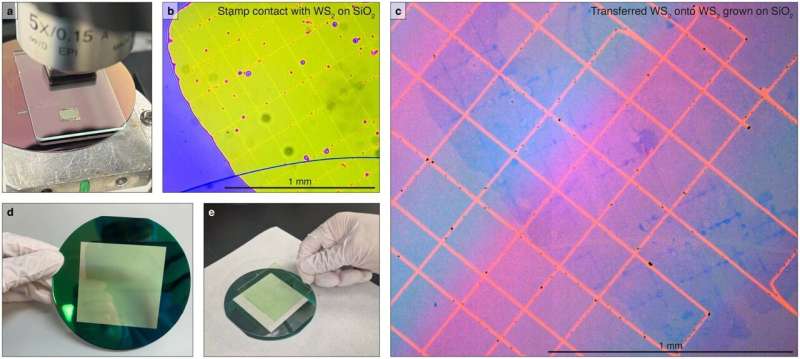This article has been reviewed according to Science X's editorial process and policies. Editors have highlighted the following attributes while ensuring the content's credibility:
fact-checked
peer-reviewed publication
trusted source
proofread
Atomically precise assembly of 2D materials paves way for next-generation electronics

Researchers at the University of Manchester have made a breakthrough in the transfer of 2D crystals, paving the way for their commercialization in next-generation electronics. This technique, detailed in a recent Nature Electronics article, utilizes a fully inorganic stamp to create the cleanest and most uniform 2D material stacks to date.
The team, led by Professor Roman Gorbachev from the National Graphene Institute, employed the inorganic stamp to precisely "pick and place" 2D crystals into van der Waals heterostructures of up to eight individual layers within an ultra-high vacuum environment. This advancement resulted in atomically clean interfaces over extended areas, a significant leap forward compared to existing techniques and a crucial step towards the commercialization of 2D material-based electronic devices.
Moreover, the rigidity of the new stamp design effectively minimized strain inhomogeneity in assembled stacks. The team observed a remarkable decrease in local variation—over an order of magnitude—at "twisted" interfaces, when compared to current state-of-the-art assemblies.
The precise stacking of individual 2D materials in defined sequences holds the potential to engineer designer crystals at the atomic level, with novel hybrid properties. While numerous techniques have been developed to transfer individual layers, almost all rely on organic polymer membranes or stamps for mechanical support during the transition from their original substrates to the target ones. Unfortunately, this reliance on organic materials inevitably introduces 2D material surface contamination, even in meticulously controlled cleanroom environments.
In many cases, surface contaminants trapped between 2D material layers will spontaneously segregate into isolated bubbles separated by atomically clean areas. "This segregation has allowed us to explore the unique properties of atomically perfect stacks," explained Professor Gorbachev. "However, the clean areas between contaminant bubbles are generally confined to tens of micrometers for simple stacks, with even smaller areas for more complex structures involving additional layers and interfaces."
He further elaborated, "This ubiquitous transfer-induced contamination, along with the variable strain introduced during the transfer process, has been the primary obstacle hindering the development of industrially viable electronic components based on 2D materials."
The polymeric support used in conventional techniques acts as both a source of nanoscale contamination and an impediment to efforts to eliminate pre-existing and ambient contaminants. For instance, adsorbed contamination becomes more mobile at high temperatures and may be entirely desorbed, but polymers cannot typically withstand temperatures above a few hundred degrees. Additionally, polymers are incompatible with many liquid cleaning agents and tend to outgas under vacuum conditions.
"To overcome these limitations, we devised an alternative hybrid stamp, comprising a flexible silicon nitride membrane for mechanical support and an ultrathin metal layer as a sticky 'glue' for picking up the 2D crystals," explained Dr. Nick Clark, second author of the study.
"Using the metal layer, we can carefully pick up a single 2D material and then sequentially 'stamp' its atomically flat lower surface onto additional crystals. The van der Waals forces at this perfect interface cause adherence of these crystals, enabling us to construct flawless stacks of up to eight layers."
After successfully demonstrating the technique using microscopic flakes mechanically exfoliated from crystals using the "sticky tape" method, the team scaled up the ultraclean transfer process to handle materials grown from the gas phase at larger sizes, achieving clean transfer of mm-scale areas. The ability to work with these "grown" 2D materials is crucial for their scalability and potential applications in next-generation electronic devices.
More information: Wendong Wang et al, Clean assembly of van der Waals heterostructures using silicon nitride membranes, Nature Electronics (2023). DOI: 10.1038/s41928-023-01075-y
Journal information: Nature Electronics
Provided by University of Manchester



















